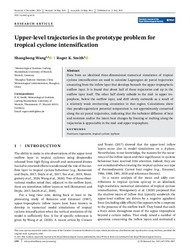Upper‐level trajectories in the prototype problem for tropical cyclone intensification
DOI: https://doi.org/10.1002/qj.4110
Persistent URL: http://resolver.sub.uni-goettingen.de/purl?gldocs-11858/9531
Persistent URL: http://resolver.sub.uni-goettingen.de/purl?gldocs-11858/9531
Wang, Shanghong; Smith, Roger K., 2021: Upper‐level trajectories in the prototype problem for tropical cyclone intensification. In: Quarterly Journal of the Royal Meteorological Society, Band 147, 738: 2978 - 2987, DOI: 10.1002/qj.4110.
 |
Dokument öffnen: |
Data from an idealized three‐dimensional numerical simulation of tropical cyclone intensification are used to calculate Lagrangian air parcel trajectories emanating from the inflow layer that develops beneath the upper‐tropospheric outflow layer. It is found that about half of these trajectories end up in the outflow layer itself. The other half slowly subside to the mid‐ to upper troposphere, below the outflow layer, and drift slowly outwards as a result of a relatively weak overturning circulation in that region. Calculations show that pseudo‐equivalent potential temperature is not approximately conserved along the air parcel trajectories, indicating that the turbulent diffusion of heat and moisture and/or the latent heat changes by freezing or melting along the trajectories is appreciable in the mid‐ and upper troposphere. Three‐dimensional numerical simulations of tropical cyclone evolution have shown the existence of inflow layers in the upper troposphere, both above and below the outflow layer there. These inflow layers have received little attention in the literature until quite recently. In this study we investigate air parcel trajectories initialized in the inflow layer below the outflow layer to determine where the inflowing air ends up: does it ascend in the eyewall updraught or descend outside this updraught? We discuss some implications of this upper‐level inflow for the structure of pseudo‐equivalent potential temperature in the upper troposphere.
Statistik:
ZugriffsstatistikSammlung:
This is an open access article under the terms of the Creative Commons Attribution License, which permits use, distribution and reproduction in any medium, provided the original work is properly cited.

